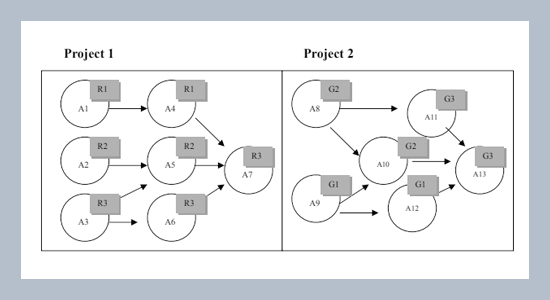REFERENCES
- [1] Liu, Z., and Cheng, T. C. E. 2002. Scheduling with job release dates, delivery times and preemption penalties. Information Processing Letters, 82: 107-111.
- [2] Brasel, H., and Hennes, H. 2004. On the open-shop problem with preemption and minimizing the average completion time. European Journal of Operational Research, 157, (3): 607-619.
- [3] Averbakh, I., and Xue, Z. 2007. On-line supply chain scheduling problems with preemption. European Journal of Operational Research, 181, (1): 500-504.
- [4] Herroelen, W., De Reyck, B., and Demeulemeester, E. 1998. Resource-constrained project scheduling: a survey of recent development. Computers and Operations, 25, (4): 279-302.
- [5] Carlier, J., and Neron, E. 2003. On linear lower bounds for the resource constrained project scheduling problem. European Journal of Operational Research, 149, (2): 314-324.
- [6] Carlier, J., and Neron, E. 2007. Computing redundant resources for the resource constrained project scheduling problem. European Journal of Operational Research, 176, (3): 1452-1463.
- [7] Damay, J., Quilliot, A., and Sanlaville, E. 2007. Linear programming based algorithms for preemptive and non-preemptive RCPSP. European Journal of Operational Research, 182, (3): 1012-1022.
- [8] Alba, E., and Chicano, J. F. 2007. Software project management with GAs. Information Sciences, 177: 2380-2401.
- [9] Ranjbar, M. R., and Kianfar, F. 2007. Solving the discrete time/resource trade-off problem in project scheduling with genetic algorithms. Applied Mathematics and Computation, 191, (2): 451-456.
- [10] Kurtulus, I., And Davis, E. W. 1982. Multi-project scheduling: categorization of heuristic rules performance. Management Science, 28: 161-172.
- [11] Dumond, J., and Mabert, V. A. 1988. Evaluating project scheduling and due date assignment procedures: an experimental analysis. Management Science, 34, (1): 101-118.
- [12] Dumond, J. 1992. In a multi-resource environment, how much is enough? International Journal of Production Research, 30, (2): 395-410.
- [13] Dumond, E. J., and Dumond, J. 1993. An examination of resourcing policies for the multi-resource problem. International Journal of Operations and Production Management, 13, (5): 54-76.
- [14] Oguz, O., and Bala, H. 1994. A comparative study of computational procedures for the resource constrained project scheduling problem. European Journal of Operational Research, 72: 406-416.
- [15] Yang, B., Geunes, J., and O’Brien, W. J. 2004. A heuristic approach for minimizing weighted tardiness and overtime costs in single resource scheduling. Computers and Operations Research, 31, (8): 1273-1301.
- [16] Hartmann, S., and Kolisch, R. 2000. Experimental evaluation of state-of-the-art heuristics for the resource-constrained project scheduling problem. European Journal of Operational Research, 127, (2): 394-407.
- [17] Kolisch, R., and Hartmann, S. 2006. Experimental investigation of heuristics for resource-constrained project scheduling: an update. European Journal of Operational Research, 174, (1): 23-37.
- [18] Rabbani, M., Fatemi Ghomi, S. M. T., Jolai, F., and Lahiji, N. S. 2007. A new heuristic for resource-constrained project scheduling in stochastic networks using critical chain concept. European Journal of Operational Research, 176, (2): 794-808.
- [19] Buddhakulsomsiri, J., and Kim, D. S. 2007. Priority rule-based heuristic for multi-mode resource-constrained project scheduling problems with resource vacations and activity splitting. European Journal of Operational Research, 178, (2): 374-390.
- [20] Beyer, H. G., and Sendhoff, B. 2007. Robust optimization –a comprehensive survey. Computer Methods in Applied Mechanics and Engineering, 196, (33-34): 3190-3218.
- [21] Liou, Y. H. A., Lin, P. P., Lindeke, R. R., and Chiang, H. D. 1993. Tolerance specification of robot kinematic parameters using an experimental design technique - the Taguchi method. Robotics and Computer-Integrated Manufacturing, 10, (3): 199-207.
- [22] Kim, Y. S., and Yum, B. J. 2004. Robust design of multilayer feed forward neural networks: an experimental approach. Engineering Applications of Artificial Intelligence, 17, (3): 249-263.
- [23] Savas, O., and Kayilci, R. 2007. Application of Taguchi’s methods to investigate some factors affecting microporosity Formation in A360 aluminium alloy casting. Materials and Design, 28, (7): 2224-2228.
- [24] Peace, G. S. 1993. “Taguchi methods: a hands-on approach”, Addison Wesley, Massachusetts, U.S.A.
- [25] Santell, M. P., Jung, Jr., J. R., and Warner, J. C. 1992. Optimization in project coordination scheduling through application of Taguchi Methods. Project Manage-ment Journal, 23, (3): 5-16.
- [26] Tsai, H. T., Moskowitz, H., and Lee, L. L. 2003. Human resource selection for software development projects using Taguchi’s parameter design. European Journal of Operational Research, 151: 167-180.
- [27] Bock, D. B., and Patterson, J. H. 1990. A comparison of due date setting, resource assignment, and job preemption heuristics for the Multiproject Scheduling Problem. Decision Science, 21: 387-402.






